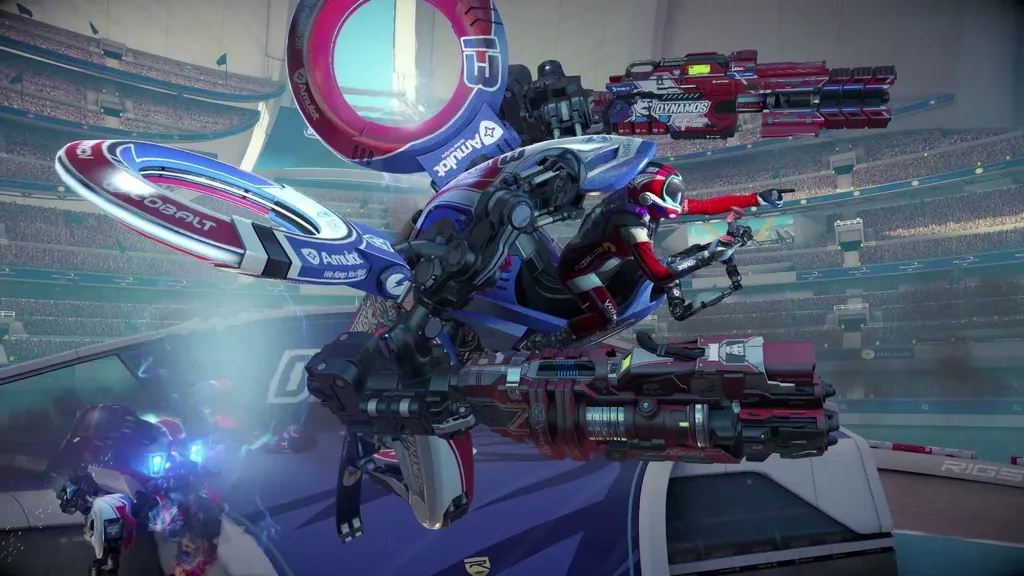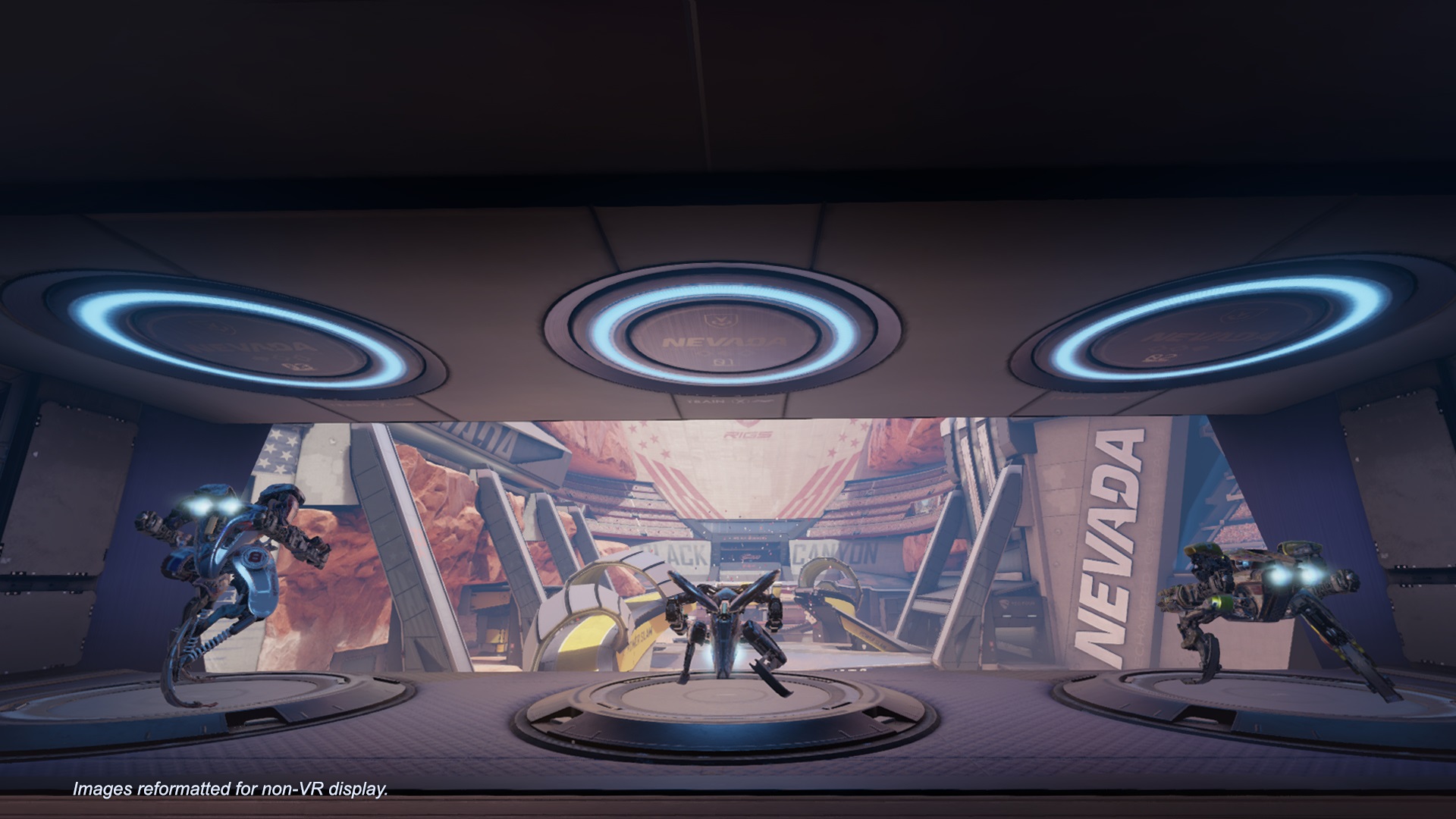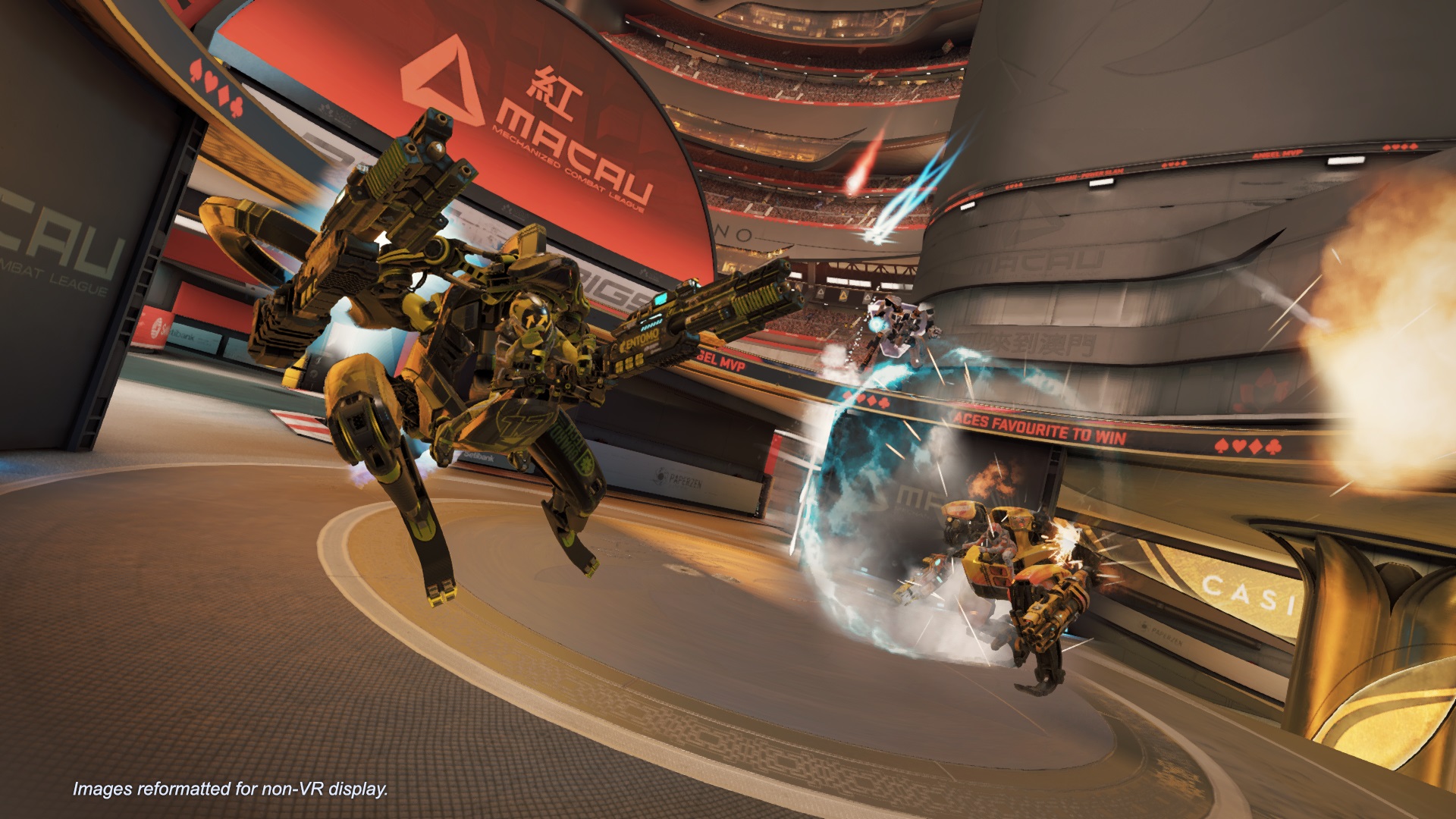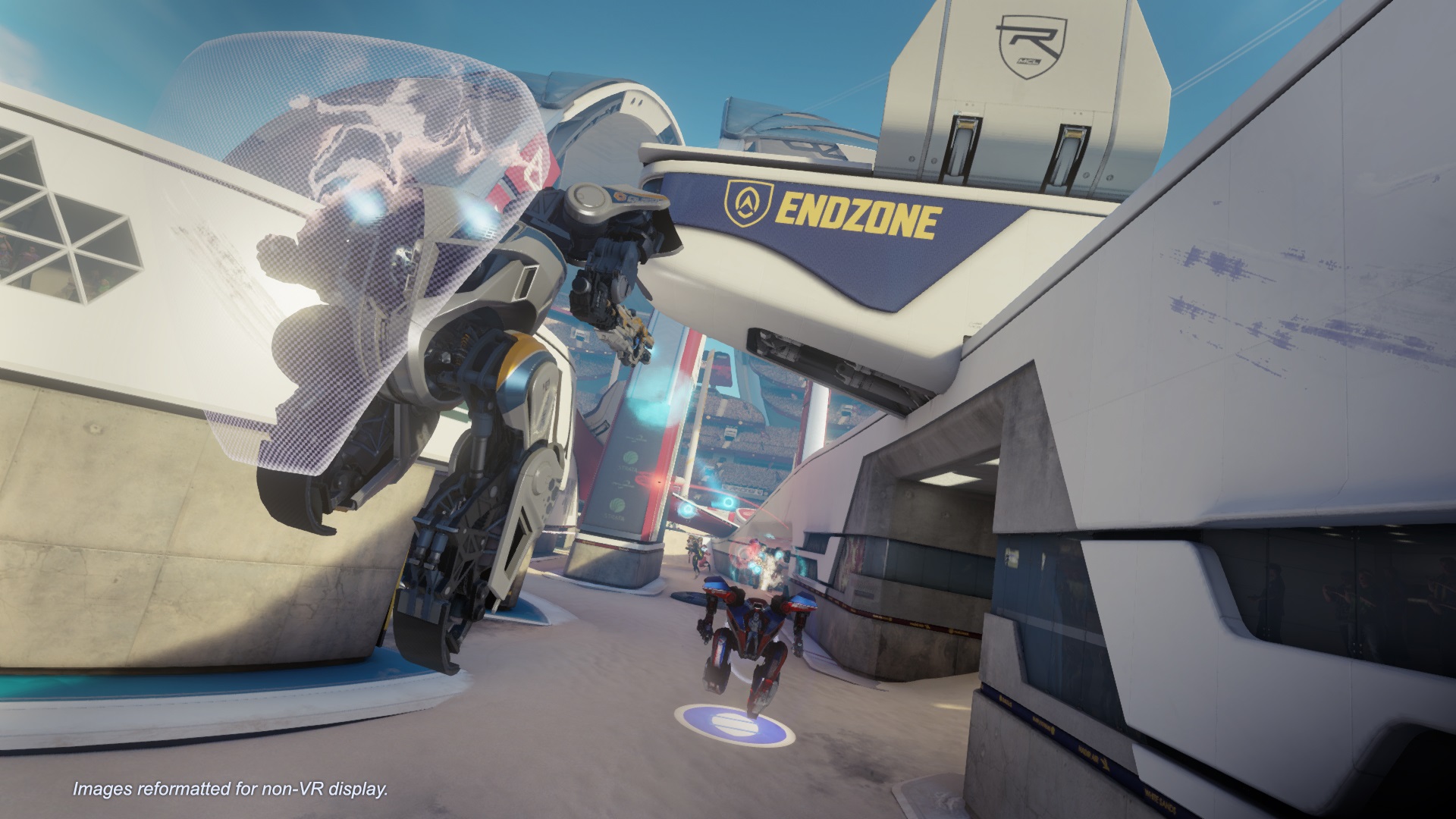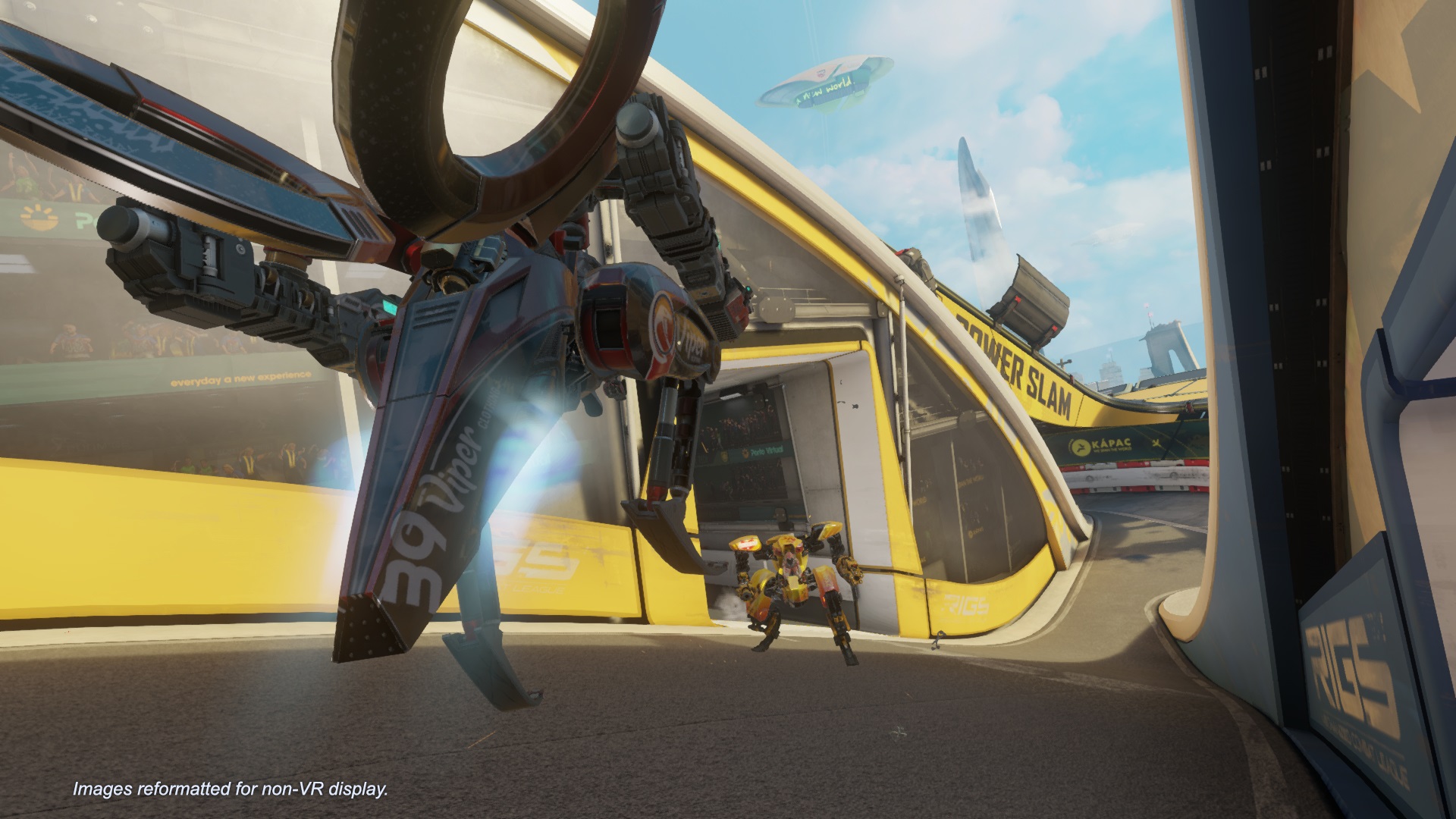You’d think a studio like Sony’s Guerrilla would have things boiled down to a relatively simple science at this point. The developer as a whole is most well-known for the long-running series of Killzone games — which span multiple platforms and story arcs — but the Guerilla Cambridge team specifically has a much more varied and eclectic track record. Naturally, asking them to take on the challenge of building a VR-exclusive competitive multiplayer shooter to be available on day 1 with the new platform was no small task.
The ‘Review Guide’ for Rigs, a document that briefs reviewers like myself on the mechanics and content of a game, opens with a page-long introduction about the mission behind the project. After two full years of development (and scrapping/reworking several ideas) leading up to the launch of Sony’s flagship virtual reality headset, the wait is finally over. If you’re a fan of intense, fast-paced competitive multiplayer shooters, this is the game you’ve been waiting for.
From the moment you start Rigs, it immediately feels like one of the most polished and completed games available on PS VR. The introductory cutscene has you whipping your head around, marveling at the action and flashes on screen. Then before you even reach any of the game’s core menus, you’re taken through a lengthy tutorial sequence with full voice acting.
Everything in Rigs from top to bottom is stylized as if you are playing a game based on a futuristic combat sport. For example, your Chief walks you through all of the different control mechanics, such as using the analog sticks on your Dualshock 4 controller and turning your head inside the headset. After shooting targets you’re taken out into a training arena to put your skills to the test. Luckily, the team at Guerrilla are aware of some players’ sensitivity to movement in VR, so they’ve added a handful of very particular comfort options.
For starters, the filed of vision (FOV) on the outskirts of your eyesight will close in as you turn and look swiftly — similar to the mechanic from Eagle Flight by Ubisoft. Additionally, you can decouple your Rig’s horizontal movement from your head, causing your aiming reticle and your movement trajectory to function based on your headset and your control sticks, respectively. Finally, there is even a flat menu-based replacement for re-spawning, as opposed to literally getting ejected into the air out of your cockpit.
Actual gameplay in Rigs is fast and satisfying. The type of Rig you’re using will influence your speed, damage, and abilities, but they all boost and run around arenas no matter what. Rather than simply differentiating your loadouts with weapons and abilities, you can also alternate between three core power modes at any time: turbo, repair, and impact. Switching to turbo mode boosts my speed, while repair mode slowly heals my Rig, and impact mode increases my damage potential. Racking up kills and picking up glowing yellow orbs fills your Overdrive meter and when that’s active all three of your modes are turned on simultaneously.
Once you get your bearings, you’ll be pleased to find a litany of things to do. In the past when we got hands-on time with the game, it seemed like a relatively shallow experience. Every demo we saw at public events took place on the same Dubai map and included only one game mode: Powerslam. As it turns out, there are four classes of Rigs, each of which are customizable with different weapons and abilities, as well as four distinct maps, and a total of three different game modes.
The classes of Rigs are Sentinels, Hunters, Mirages, and Tempests. Sentinels are built for defense and can emit a powerful shockwave slam, whereas Hunters are quick and agile on the ground. Mirages can double jump, affording vertical flexibility, whereas Sentinels can leap and hover in the air. Taking each of those four core classes — and augmenting them with one of the special ability modes — opens up the door for dozens of Rig combinations and team builds.
In addition to the aforementioned Powerslam, there are also Endzone and Team Takedown game modes. For all intents and purposes, Powerslam appears to be the core game mode. Think of it as a combination of robotic warfare and basketball. Essentially, you must enter Overdrive — by earning kills and finding orbs — and then ‘dunking’ your Rig itself through the center ring of the map. The team with the most points by the end wins.
Endzone on the other hand is like a mixture of American football and soccer, as there is a literal ball that you and your team must get through the goal of the other team. You can pass it back and forth and kill enemies carrying the ball. In practice, it feels similar to one-flag capture the flag from other traditional shooting games. Finally, Team Takedown is essentially Team Deathmatch.
Beyond the core game modes there is more than enough to keep you busy in Rigs. When you’re not playing online against other actual humans, you can play in the Offline career mode, which sticks you on a team and tasks you with rising up the ranks and earning fans and credits through competition. There is plenty of incentive to play both online and offline as the content you unlock and earn is cross-compatible between the two modes.
From the Headquarters menu, you can choose your Sponsorship challenges, which function much like bounties or challenge missions in other games, and will ask you to ‘Earn 5 Takedowns in a Match’ or something similar.
Completing the bounty earns you a reward, such as a new uniform, helmet, or podium celebration. You can also spend your currency to unlock different classes and types of Rigs. Everything feeds into this system of progression, unlocking, and customizing and the team at Guerrilla Cambridge have done an excellent job of striking that difficult balance.
Even though the singleplayer content is serviceable and gets the job done when you either don’t have friends online or don’t feel like playing with other people, the real star of the experience is clearly the competitive multiplayer. This is, far and away, designed from the ground up to be played against other actual people. Just like in any shooter, that’s where the game really shines. The simple obstacle-based or time-limit-restrictive Trial missions don’t add much.
To that end, it would have been nice to see options for more team-based customization, or the creation of custom teams and leagues within the game. Since this is intended to be a fictional future sport, it would have seemingly been a no-brainer to let people create more of their own branding and recruit friends onto their online ranked squads. Perhaps that’s something that can be added in a future update. A cooperative game mode would have been a welcomed addition as well.
Rigs is a game built to last for the PS VR ecosystem. More maps, game modes, Rigs, and customization options would go a long way towards extending the game’s life span, whether it be through timed exclusive events, free content additions, or paid downloadable content.
Guerrilla Cambridge has crafted a superb first-person shooter exclusively for PlayStation VR that utilizes the unique aspects of virtual reality to deliver an exciting gameplay experience you won’t find anywhere else. If Battlezone was too slow and cooperative for your tastes, then this is the launch day game for you. Rigs is a must-play for competitive shooter fans splurging on Sony’s VR headset this holiday season.
Rigs: Mechanized Combat League releases for PlayStation VR on October 13th for $49.99.
Read our Game Review Guidelines for more information on how we arrived at this score.

